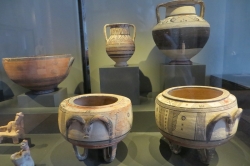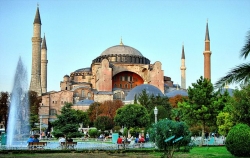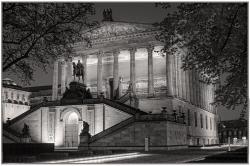ABOUT Deutsches Museum
The Deutsches Museum (officially Deutsches Museum von Meisterwerken der Naturwissenschaft und Technik) at Munich, Germany, is the world's largest museum of science and technology, with about 28,000 exhibited objects from 50 fields of science and technology. It receives about 1.5 million visitors per year.
The museum was founded on 28 June 1903, at a meeting of the Association of German Engineers (VDI) as an initiative of Oskar von Miller. It is the largest museum in Munich. For a period of time the museum was used to host pop and rock concerts including The Who, Jimi Hendrix and Elton John.
The main site of the Deutsches Museum is a small island in the Isar river, which had been used for rafting wood since the Middle Ages. The island did not have any buildings before 1772 because it was regularly flooded prior to the building of the Sylvensteinspeicher.
In 1772 the Isar barracks were built on the island and, after the flooding of 1899, the buildings were rebuilt with flood protection. In 1903 the city council announced that they would donate the island for the newly built Deutsches Museum. The island formerly known as Kohleninsel (coal island) was then renamed Museumsinsel.
A few months before the 1903 meeting of the Society of German Engineers, Oskar von Miller gathered a small group who supported his desire to found a science and technology museum. In a showing of support this group spontaneously donated 260,000 marks to the cause and elected a "Provisional Committee" to get the ball rolling.
In June 1903, Prince Ludwig agreed to act as patron of the museum and the city of Munich donated Coal Island as a site for the project. In addition, exhibits began to arrive from Munich, Germany, and abroad including collections from the Bavarian Academy. As no dedicated museum building existed, the exhibits were displayed in the National Museum.
On 12 November 1906, the temporary exhibits at the National Museum were ceremonially opened to the public and on November 13 the foundation stone was laid for the permanent museum.
The first name of the museum, the "German Museum for Masterpieces of Natural Science and Technology", was not meant to limit the museum to German advances in science and technology, but to express the importance of science and technology to the German people.
Oskar von Miller opened the new museum on his 70th birthday, 2 May 1925, after a delay of almost ten years. From the beginning, the museum displays are backed up by documents available in a public library and archives, which are open seven days a week to ensure access to the working public.
Before and during World War II the museum was put on a shoestring budget by the Nazi party and many exhibits were allowed to get out of date with a few exceptions such as the new automobile room dedicated 7 May 1937. By the end of 1944 the museum was badly damaged by air bombings with 80% of the buildings and 20% of the exhibits damaged or destroyed. As Allied troops marched into Munich in April 1945, museum director, Karl Bässler, barely managed to keep the last standing bridge to Museum Island from being blown up by retreating German troops.
Following the war the museum had to be closed for repairs and temporary tenants, such as the College of Technology and the Post Office used museum space as their own buildings were being reconstructed. The Museum was also home to the Central Committee of the Liberated Jews, representing Jewish displaced persons in the American Zone of Germany after the war, as well as to UNRRA that operated a camp for displaced persons and later an International University with over 2000 students.
In November 1945, the library was able to reopen, followed by the congress hall in January 1946. A special exhibit on fifty years of the Diesel engine opened in October 1947 and the regular exhibits began reopening in May 1948. Not until 1965, more than twenty years after the end of the war in Germany, did the exhibit area match (and then exceed) pre-war size.
During the 1950s, the museum focused on natural sciences rather than technology and many of the traditional large exhibits, such as civil engineering, were reduced in size to make way for more modern technological advances.
The museum was founded on 28 June 1903, at a meeting of the Association of German Engineers (VDI) as an initiative of Oskar von Miller. It is the largest museum in Munich. For a period of time the museum was used to host pop and rock concerts including The Who, Jimi Hendrix and Elton John.
The main site of the Deutsches Museum is a small island in the Isar river, which had been used for rafting wood since the Middle Ages. The island did not have any buildings before 1772 because it was regularly flooded prior to the building of the Sylvensteinspeicher.
In 1772 the Isar barracks were built on the island and, after the flooding of 1899, the buildings were rebuilt with flood protection. In 1903 the city council announced that they would donate the island for the newly built Deutsches Museum. The island formerly known as Kohleninsel (coal island) was then renamed Museumsinsel.
A few months before the 1903 meeting of the Society of German Engineers, Oskar von Miller gathered a small group who supported his desire to found a science and technology museum. In a showing of support this group spontaneously donated 260,000 marks to the cause and elected a "Provisional Committee" to get the ball rolling.
In June 1903, Prince Ludwig agreed to act as patron of the museum and the city of Munich donated Coal Island as a site for the project. In addition, exhibits began to arrive from Munich, Germany, and abroad including collections from the Bavarian Academy. As no dedicated museum building existed, the exhibits were displayed in the National Museum.
On 12 November 1906, the temporary exhibits at the National Museum were ceremonially opened to the public and on November 13 the foundation stone was laid for the permanent museum.
The first name of the museum, the "German Museum for Masterpieces of Natural Science and Technology", was not meant to limit the museum to German advances in science and technology, but to express the importance of science and technology to the German people.
Oskar von Miller opened the new museum on his 70th birthday, 2 May 1925, after a delay of almost ten years. From the beginning, the museum displays are backed up by documents available in a public library and archives, which are open seven days a week to ensure access to the working public.
Before and during World War II the museum was put on a shoestring budget by the Nazi party and many exhibits were allowed to get out of date with a few exceptions such as the new automobile room dedicated 7 May 1937. By the end of 1944 the museum was badly damaged by air bombings with 80% of the buildings and 20% of the exhibits damaged or destroyed. As Allied troops marched into Munich in April 1945, museum director, Karl Bässler, barely managed to keep the last standing bridge to Museum Island from being blown up by retreating German troops.
Following the war the museum had to be closed for repairs and temporary tenants, such as the College of Technology and the Post Office used museum space as their own buildings were being reconstructed. The Museum was also home to the Central Committee of the Liberated Jews, representing Jewish displaced persons in the American Zone of Germany after the war, as well as to UNRRA that operated a camp for displaced persons and later an International University with over 2000 students.
In November 1945, the library was able to reopen, followed by the congress hall in January 1946. A special exhibit on fifty years of the Diesel engine opened in October 1947 and the regular exhibits began reopening in May 1948. Not until 1965, more than twenty years after the end of the war in Germany, did the exhibit area match (and then exceed) pre-war size.
During the 1950s, the museum focused on natural sciences rather than technology and many of the traditional large exhibits, such as civil engineering, were reduced in size to make way for more modern technological advances.






